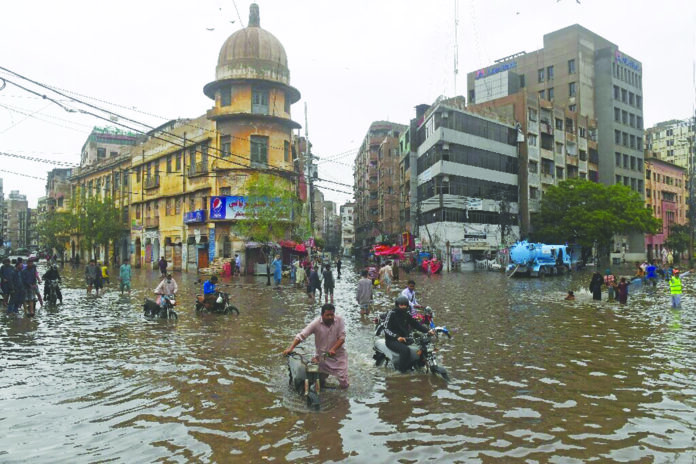Pakistan is significantly prone to climate change effects due to several factors, including its geographical location, high reliance on agricultural and water resources, an inefficient emergency preparedness system, and the limited adaptive capacity of the general populace.
Despite having a contribution of less than one percent to global carbon emissions, it is ranked as the most vulnerable country to climate change effects. A year after the devastating floods of 2022, Pakistan is still struggling to recover, with 1.8 million people residing close to floodwater that is contaminated and stagnant. Moreover, another monsoon season is around the corner, to worsen the situation. The most recent record-level rain of 291mm in Lahore and its outskirts is a reflection that worse is still to come. The most concerning fact is that it has increased the vulnerability of its already underprivileged population, affecting 33 million people, and areas already having the lowest score on the Human Development Index have been the hardest hit. The loss of 1500 human lives is an immeasurable tragedy, portraying a subdued picture of human loss due to climate disasters. Thus, the plight of Pakistan is an utter reminder of the urgent need for global community action in fighting climate change and its distressing effects.
Though the human cost is a significant one that occurred, the economic fallout is another dimension of the calamitous hit, with an estimated economic loss of $30 billion. Substantial damage to infrastructure occurred, with 500,000 km of roads and 269 bridges damaged. This in turn disconnected the local communities and hindered the relief efforts of the authorities at the time, and eventually, the transportation cost increased. Moreover, the education of countless children is jeopardized, as 18590 schools were damaged in those areas that were already facing serious educational crises. Thus, this will aggravate the downward spiral effect in the literacy rate in Sindh and Balochistan.
Economically, agriculture is a vital lifeline for the rural populace in Pakistan. Therefore, any disruption in this sector strengthens socio-economic issues. The distressing floods have resulted in 750,000 livestock deaths in both Sindh and Balochistan, aggravating food security and leaving the farmers of flood-hit areas in dire straits. This portrays the fact that poverty will increase at a significant rate, if timely measures are not taken. In addition, Pakistan’s already crippling agricultural sector was further destroyed by heavy monsoon rains, which covered 18,000 sq km of cropland, resulting in a significant reduction of 45 percent in cotton production, a major export product of Pakistan. Besides, Pakistan witnessed a 60 percent decline in mango production last season due to climate change, of which Pakistan is the fourth largest exporter in the world. Thus, the country is confronted with serious economic losses due to the floods.
Earlier, it was claimed that due to bad governance funds were diverted from their intended purpose. Therefore, good governance and proper checks and balances are prerequisites for effective utilization of any aid. For the current monsoon, authorities need to have a practical and implementable disaster management plan to deal with such a disastrous situation. In the longer run, proper rainwater harvesting systems need to be adapted in all cities prone to flooding, while transformation of agri-food systems and strengthening human capital should be prioritized to achieve equitable and sustainable development and climate resilience.
The monsoon season of 2022 has resulted in a heightened risk of disease spread. The stagnant floodwater provides a favourable condition for pathogens to emerge, and a vast number of these displaced people have poor hygiene and sanitation in their impermanent accommodations. Notably, there has been an outbreak of waterborne diseases (cholera and diarrhea, malaria, skin and eye infections) across Sindh and Balochistan. Currently, the health facilities in their peripheries are not effective enough to deal with this spread, as 1460 health facilities have been destroyed by the floods, which severely compromised the already inadequate0 healthcare system.
As the monsoon season is impending again, the country is in a serious economic crisis with a bleak picture of damage from the previous year. Earlier in June, winds and heavy rainfall killed 27 people, including 8 children and 200 livestock, in four districts of Khyber Pakhtunkhwa province. In the majority of areas of the country, which were severely affected by the heavy rains last year, there has been no progress. Reconstruction of houses and water scheme infrastructure has not been completed. Besides, the health infrastructure in parts of the country, particularly in Sindh and South Punjab, is damaged, exacerbating the woes of the people. There is a great fear that the monsoon season this year will add fuel to the fire.
In the past, the drainage system and infrastructure could not withstand heavy rainfall. Consequently, Pakistan should learn from the experience of 2022, make the necessary preparations for mitigating disaster impacts by developing a climate-resilient infrastructure. While some countries and international organizations have helped Pakistan by supplying food, tents, medicines, and other relief supplies, these are short-term help. The Country is already in a serious economic crisis with low foreign exchange reserves, currency depreciation, and a high inflation rate. Amid this situation, it is difficult for Pakistan to bear this massive cost. For this reason, at the Geneva Conference, Pakistan secured pledges of over $10.57 billion from different donors for areas destroyed by the massive floods but the aid has not reached yet due to several reasons.
Earlier, it was claimed that due to bad governance funds were diverted from their intended purpose. Therefore, good governance and proper checks and balances are prerequisites for effective utilization of any aid. For the current monsoon, authorities need to have a practical and implementable disaster management plan to deal with such a disastrous situation. In the longer run, proper rainwater harvesting systems need to be adapted in all cities prone to flooding, while transformation of agri-food systems and strengthening human capital should be prioritized to achieve equitable and sustainable development and climate resilience.






















